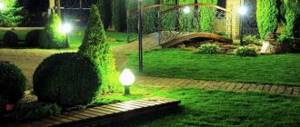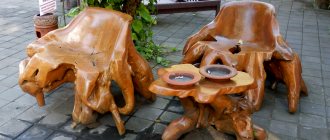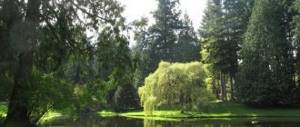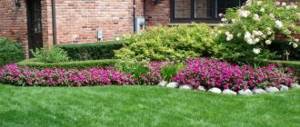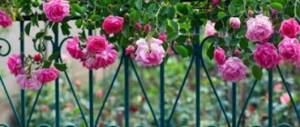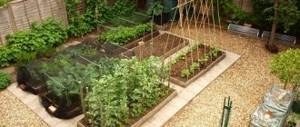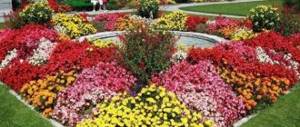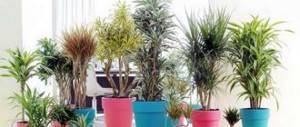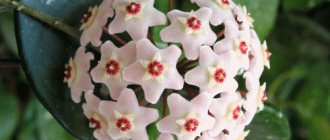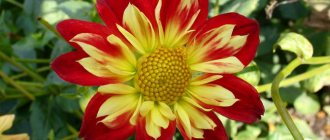Decorative trees for the garden: names and descriptions with photos
Planning a garden should take into account its area. Therefore, when selecting plants, it is important to take into account their future size.
Ornamental trees for the garden are divided into tall, medium-sized and low-growing:
- tall - from 15 m in height and above;
- medium-sized - from 10 to 15 m in height;
- short - up to 10 m in height.
In practice, tall trees are rarely planted in standard garden plots, since they can shade the territory of neighbors. When planning a garden, it is better to pay attention to medium-sized and low-growing plants, as well as shrubs.
Jung's Birch.
A low tree, which is a varietal variety of silver birch. It grows slowly, reaches a height of 6 meters without shaping, and up to 3 meters with shaping pruning. It has a spherical habit and thin hanging branches.
Fan or palm maple.
A low-growing plant with a low growth rate, reaching a height of no more than 5 meters. It has an interesting umbrella crown, especially decorative during flowering and in autumn. Suitable for regions with mild winters.
Yellow acacia (Caragana arborescens).
The plant has a tree or shrub form, with complex decorative leaves. It tolerates pruning easily and can be used to form a tall hedge. At the beginning of summer it blooms with fragrant moth flowers with a yellow corolla. The average height of the tree is 5-6 meters. Winters well in central Russia.
Chestnut Fastigiata.
A variety of horse chestnut that grows quickly, but does not exceed a height of 8 meters. An unpretentious plant with beautiful foliage that easily tolerates difficult soils and poor environmental conditions. It is especially decorative in May, during flowering.
Common ash Pendula.
A fast growing tree reaching a maximum height of 10 meters. It has a weeping crown and highly decorative foliage. It winters well, but requires a lot of light and space, since the diameter of the crown can also reach 10 meters.
Deciduous deciduous trees usually form the basis of an ornamental garden.
Plot
70 votes
+
Vote for!
—
Vote against!
All summer residents want to see their garden plot landscaped and surrounded by green trees. There are hundreds of thousands of different plants in the world that will make a great addition to the flowers that are planted in your garden. Shrubs, deciduous and coniferous trees will decorate your site. And if you set up an orchard next to your home, you can provide your family with fresh fruits.
Features of the location of trees on the site
It is impossible to imagine a garden without vegetation. The green frame of a house can enliven even the most unremarkable area. It is trees and shrubs that form the basis of the plant design of any territory. There are several ways to locate trees on a site.
Ordinaries
These are lonely trees that attract a lot of attention. Therefore, they should look flawless throughout the season and have no flaws. A lush shrub or spreading tree will look especially decorative. If the area is small, then it is enough to plant only one serious tree.
Many people like the idea of starting a family tree that will grow for several generations, preserving the history of the family. Having planted a Christmas tree, you will have a great opportunity to dress it up for the New Year, and the children will dance around it. If the area is modest, you can plant the Christmas tree together in a group of other plants.
Groups
These are compositions created from several plants of different or one species. For planting in a group, select representatives of the flora according to the principle of tiers. Be sure to plant tall shrubs in front of large trees, and it is advisable to place smaller ones in front of them. To add brightness to a group of plants, choose specimens with variegated leaves or beautiful flowers.
On your site, you can place a group in the center of the garden; in this case, plant the tallest plants in the middle. If the group is viewed exclusively from one side and is placed near the facade of a building or fence, then the height of the plants should increase towards this building.
When planning a group, also consider the requirements of the plants. They should not shade each other, unless, of course, you prefer shade-tolerant species. In addition, it is recommended to maintain distances between plants when planting trees and shrubs.
If you bought small plants and have no idea how much they will grow over time, be sure to take an interest in the parameters of certain plants. Check the shape and diameter of the crown, the height of the tree and its growth rate. To avoid mistakes, it is also recommended to draw up a dendroplan in advance. Without it, there is no point in buying plants and going to the garden center. Otherwise, chaos will ensue in the garden plot.
Hedges
This type of placement of plants on a site is a dense linear planting of shrubs. Sometimes hedges are formed from trees. They can grow freely or require cutting. But in any case, they act as good protection from the wind, unnecessary sounds, and prying eyes. Hedges enclose the area and also divide the area into different zones.
When choosing plants for hedges, it is recommended to take their height into account. Remember that it is unlikely that you can make a low border from a large tree. On the other hand, small bushes are not suitable for creating a green wall. You should also select the leaves, because they should be of the optimal size, as in the photo of tree planting. Small forms of large-leaved specimens look ugly. It is also worth buying only winter-hardy species.
Alleys
These are pedestrian paths, lined on all sides with trees or shrubs. In this case, a certain rhythm is observed. As a rule, close planting of trees is practiced in alleys: in this case, specimens should be placed one after another at a distance of about 2–3 m, forming a closed arch. Remember that arranging an alley requires a lot of free space, so it is not advisable to create them in small areas.
Criteria for selecting trees for planting
The entire range of shrubs and trees that are intended for planting in the countryside is divided into two categories. This is the main and additional material.
The main range consists of sustainable species that have proven themselves over the centuries. This category includes maple, birch, willow, poplar, linden, elm, ash, larch, chestnut, oak, walnut, thuja, spruce, and juniper.
An additional assortment is represented by plants that are small in size and complement garden compositions. Among them are rowan, cherry, bird cherry, apple tree, lilac, barberry, dogwood, cotoneaster, and hawthorn.
It is recommended to select material for planting on your site taking into account the following requirements:
- Fruiting. If you are interested in this aspect, pay attention to berry bushes and fruit trees in landscape design.
- Decorative. It is important to take into account here that trees are decorative constantly throughout the season, or change their decorativeness. In the first case, give preference to coniferous ones, in the second - deciduous ones.
- Plant protection. Groups of plants on your site can protect a certain area, strengthen the soil, and protect from the wind. If all this is important to you, do not forget about bushes and climbing plants that will hide the area from prying eyes.
Deciduous trees
Trees are perennial plants in which the main skeletal axis is well defined, which remains until the end of life, and the crown is formed by a bunch of large leaves, lateral branches and shoots. The impression of plants is created by their shape, the color of the foliage, and the smell of the flowers.
When choosing trees for planting, it is recommended to consider the following signs:
- Bloom. The main sign of a tree’s decorative value is its flowering. Magnolia and sakura can boast of beautiful flowers, which are usually placed in small groups or individually to enhance the perception of the beauty of the flowers. However, in most cases, trees acquire a colorful appearance only during the flowering period with small individual flowers, or inconspicuous inflorescences. This category includes maple, acacia, bird cherry, willow, and chestnut.
- Aroma. Tree species with fragrant flowers are of great value for creating a garden on your site. The smell intensifies in the evening or at night. Among the woody fragrant plants, linden and bird cherry are distinguished.
- Time of appearance of flowers. The period when flowers appear on the trees is also of great importance for the summer resident. In this case, despite the plainness of some, their early appearance is appreciated. The earliest flowers to bloom are dogwood, hazel and goat willow.
- Decorative fruits. A separate group includes trees that have decorative fruits and inflorescences. Red rowan fruits look inimitable on bare branches after the leaves have fallen. However, do not forget that the fruits can clog your area. Poplar fluff, for example, causes allergies.
- Leaves. The main decorative quality of trees for landscape design, of course, lies in its leaves. Here summer residents pay attention to both their color and shape. Another important indicator is the duration of the growing season.
- Leaf color. Species that are distinguished by strong branching and high density of leaves appear darker. In representatives with a sparse crown, the tone of the crown will seem lighter, because its inner part is visible. The forest beech tree, whose leaves have a shiny surface, will add splendor to your garden. Some trees are variegated in color, others are silver, others are purple or golden. It is better to use such specimens as an accent on the site, and not as a solid background. The color of the leaves of most representatives of the flora changes throughout the warm season, reaching its peak in the fall.
- Bark. The color of the bark of trees also varies. In beech it is light gray, in birch it is white with a black streak, in alder it is black, in poplar it is green.
- Crown shape. Branches, leaves and trunk form the crown. It can have different shapes, which affects the created landscape. It can be triangular, round, pyramidal, weeping, columnar. It can also be incorrect - when the branches grow unevenly, like those of linden, oak or maple. Often a certain shape can be obtained as a result of cutting or selection work.
The rules for planting deciduous plants are as follows:
- To determine where to plant trees on a site, it is necessary to take into account what size this species usually reaches in adulthood. There should be a space between trees that is at least half the height of an adult plant. The exception is columnar forms, which are used for hedges.
- When choosing plants, consider their requirements. They must correspond to the climatic conditions of the site, the level of humidity, lighting, and soil fertility at the dacha. For example, cypress trees should not be planted in harsh winter conditions, which they are unlikely to withstand.
- Plant on time. Container-grown specimens can be planted almost all year round. However, remember that for deciduous species, autumn or spring are better when they are leafless. It is better to plant seedlings that have an open root system in the fall.
- For planting, prepare a hole that is twice the size of the room. If the soil is marshy or heavy, be sure to provide drainage at the bottom of the hole. The hole is filled with fertile soil. After this, it needs to be compacted a little and watered generously. Do not forget about careful tree care, timely watering and pruning.
Coniferous trees
It is recommended to select coniferous trees for planting on your site in accordance with the recommendations below:
- Crown shape. The crown of some conifers has a spherical shape, as it is formed by branches of approximately the same length. Often a certain geometric shape can be achieved by regularly trimming the specimen. You can plant conifers with crowns of clear shapes in landscape compositions of a regular style, because they give the site solemnity and severity. Trees with a weeping crown shape are popular - Nootka cypress and European larch. The descending branches of such conifers direct the gaze downward. Therefore, it is customary to plant them in those places where you want to draw attention to the lower part of the landscape: near reservoirs, in flower beds and parterres.
- Phytoncidal properties. Some coniferous tree species are chosen for landscape use because they produce essential oils. The intensity of emissions is determined by the growing conditions of trees, time of year, and meteorological conditions. Thus, larch essential oils are most fragrant in the spring, but in the summer they have practically no scent. Pine emits a strong resinous odor in the summer heat.
- Bark. When choosing conifers, it is important to know that the bark can also add color to landscape paintings. After all, it has different thickness, color, texture and pattern. Pine trees with old trunks or berry yew covered with reddish-brown bark look very decorative on the site.
- Cones. Original cones are capable of diversifying the phytocomposition. In pine trees they hang from the branches, their length often reaches 25 cm. Fir cones are directed upward, so it looks like candles are placed along the tree. And in Norway spruce, young cones have a bright color - purple or reddish.
- Needles. Modern varieties of conifers provide a wide palette - all shades of green, there are also golden, yellow, blue and white needles. Since Soviet times, the favorite plants for planting in front of government institutions have been spruces with blue needles. Trees that have silver-blue needles, or rather cypress and fir, are very popular. Not inferior to them are the golden-yellow Lawson and pea cypress trees, as well as the western and folded thuja.
- Growing conditions. The popularity of coniferous trees in landscape design is also associated with their unpretentiousness and undemanding conditions for growing. Coniferous trees can be selected for almost any location. Junipers and pines prefer light, dry, sandy soils, swamp cypresses prefer areas with high humidity, and yews prefer shade. Most conifers are grown in open, sunny areas.
Rules for planting coniferous trees:
- Modern nurseries offer customers coniferous trees that have a closed root system, that is, plants planted in pots. They are convenient to buy, because they do not need urgent planting. Such specimens can be planted almost all year round. However, when the ground is frozen, it is better not to plant. Consider the growing conditions of conifers.
- Before planting, prepare a hole that is 2 times larger than the pot itself. Place the container itself in a bowl of water. This is necessary so that the earthen ball is well saturated with moisture.
- Then turn over or cut the pot and remove the plant. If the root system is very intertwined, cut through it a little and loosen the lump. Remember that conifers cannot be deepened in the soil. After planting, water the soil around the plant.
- It is useful to mulch tree trunk circles. To do this, you can use compost, grass clippings or crushed bark. Mulch retains moisture in the soil, improves the appearance of plantings, and also limits the growth of weeds.
- Further care of conifers involves loosening the tree trunk circles. Plants also need watering and fertilizing. Conifers are almost never pruned, but diseased and dried branches still need to be removed.
Ornamental shrubs
Shrubs are perennial plants that reach a height of about 60–80 cm. Their main trunk stands out only at the beginning of growth, and then gets lost among the trunks that are equal to it. If the upper parts of the shoots of a plant die off annually, then it is already a subshrub. When choosing shrubs for planting in the garden, consider the following criteria:
- Decorative. Shrubs are considered indispensable plants in gardens that have just been planted, because the trees will not demonstrate their qualities soon. And shrubs, as a rule, go through their formation period in nurseries and subsequently slightly change their size. Therefore, the overall appearance of the area that you are landscaping will initially depend on the species composition of the shrubs. According to their qualities, there are decorative deciduous shrubs, beautifully flowering ones and those that form decorative fruits, have a beautiful texture, bark color or crown shape.
- Bloom. In April and May, when the trees are not yet covered with foliage, the bushes are covered with beautiful flowers. These are dogwood, forsythia, decorative plum, lilac, hawthorn, and rose hips. Some shrubs have beautiful large flowers: tree peonies, magnolias, Syrian hibiscus.
- Fruit. In autumn, bright seeds and fruits replace flowers. This applies to hawthorns, viburnum, barberries, snowberries, rose hips. Some fruits are also edible or medicinal.
- Foliage. Shrubs have decorative foliage throughout the warm season. The leaves are usually green in color. In addition, they come in purple, gold, yellow and variegated colors. The leader in the number of colored forms is the Thunberg barberry. Also interesting are shrubs such as chameleon varieties, which are capable of changing the color of the foliage. Japanese spirea has coppery-orange leaves when young, which turn green-yellow in summer and golden-orange in fall.
- Bark. The shoots of some species are covered with brightly colored bark. This looks especially beautiful on the site in winter or early spring. Derain has shoots of a red-coral tone.
- Crown shape. The crown of shrubs can have a spherical, sheaf-shaped, cushion-shaped or creeping shape. The category of ground cover shrubs is very interesting. Such plants have horizontally spreading trunks and horizontal or ascending branches. Like many junipers, cotoneasters, and euonymus. Most often, ground cover shrubs are planted to decorate slopes, create alpine landscapes, and replace lawn cover if grass does not grow well in the area.
Rules for planting shrubs:
- Most shrubs do not require the preparation of a special substrate. It is enough to prepare the holes for planting. Fill them with garden soil mixed with compost. The exception is Heather shrubs (rhododendron, heather), which need to be planted in places with acidic soil and the addition of peat and rotten needles. They are planted and watered just like deciduous trees.
- An important manipulation for all shrubs is pruning. Immediately after planting, carry out the first pruning to enhance branching. In spring, spring sanitary pruning is required, when damaged, diseased, weak and old shoots are removed. Further pruning is carried out depending on the type and timing of flowering shrubs.
- Shrubs that are planted in hedges require regular trimming. It is customary to hold it several times a year. Trim only young shoots that have not yet become woody.
Thus, with such a variety of trees and shrubs, you can choose the necessary varieties for your site, regardless of the tree planting schemes you choose. At the same time, be sure to take into account their growth properties, cultivation requirements, and also carry out careful and timely care. This will make your garden look perfect!
Frost-resistant ornamental trees for the garden
Another important characteristic is frost resistance. Among the trees popular in landscape design, the following have excellent frost resistance:
Birch Doorenbos.
The most white-trunked among all varieties of birch.
The plant's outstanding frost resistance is due to its region of origin - the Himalayan mountains.
It is a multi-stemmed tree, up to 10 meters high. Even thin branches have a white bark.
Norway maple Royal Red.
A tree with spectacular red and black-red foliage, reaching a height of 10-12 meters. Does not require formation, independently forms an even pyramidal crown. It tolerates frosts easily, only in very severe winters can annual shoots freeze.
Mountain ash.
It reaches a height of 10-15 meters and is famous for its openwork decorative foliage, spectacular flowering and fruiting. Flowers, depending on the variety, can be white or pink, fruits - orange, red, yellow. The plant is resistant to diseases and pests and tolerates difficult climatic conditions.
High frost resistance of plants manifests itself with age. Young one- to two-year-old seedlings may require the creation of a basic winter shelter.
Rules for choosing material for planting
In landscape design, trees are the main material; they are used to complement an already created beautiful picture. To diversify it and create the required volume, preference is given to planting resistant species. These include birch, oak, maple, larch, and all tall thujas. They are the base, the starting accent elements around which the rest of the garden design is assembled.
Birch trees in landscape design Source www.archrevue.ru
There are plants that simply help to enliven a garden and give it some zest. These include fruit and berry crops: cherry, cotoneaster, rowan. The choice of certain plants depends on the objectives of landscape design. If you need to strengthen the soil and protect it from the wind, it makes sense to plant large trees with a developed root system. When there is a need to create decorative landscaping, experts recommend giving preference to deciduous trees. Fruit trees help combine decoration and harvesting.
Deciduous trees
They have a clearly defined skeleton, the elements of which are evenly distributed along the main central axis. Side branches diverge from the trunk in different directions. Shoots come from them, and foliage forms on them in bunches. It is this that helps create the desired decorative effect. The result is a fluffy crown that has a clear shape.
Experts divide all deciduous trees into two large groups: flowering and ornamental. The first include cercis, rhododendron, kelreuteru. To the second willow, maple and birch. Some look very impressive in the spring at the time of flowering, others are good in the summer, they delight the eye with an unusual crown shape, and others become the central decoration of the garden in the fall. When choosing large sizes, you need to remember seasonality.
Large deciduous trees Source pinterest.com
This might be interesting!
In the article at the following link, read about landscape design in the minimalist style.
Many deciduous trees emit a strong aroma during flowering. It can cause allergies in some. The bright strong smell will definitely attract bees from all over the area. Their bites can be very dangerous. Therefore, it is necessary to plant linden and bird cherry on a plot of land very carefully, away from a residential building. A separate group includes trees with decorative fruits. They help decorate the garden after the leaves have completely fallen. Different deciduous trees have different leaf shapes, they can have different crown colors and shapes. All these parameters must be taken into account when creating landscape design.
Decorative forms of fruit trees
Some common fruit crops can also have decorative varieties and be used on the site as decoration:
Kiku-Shidare cherry.
A variety of Japanese cherry (sakura) with drooping arched shoots. It blooms at the end of March, forming lush bunches of large double flowers of pink color. The fruits are edible and have high frost resistance.
Niedzwiecki apple tree.
A small tree with small edible apples. Valued for its highly decorative umbrella crown and magnificent flowering. The foliage turns purple in summer. The flowers are large, crimson in color. Subject to formative pruning, it does not grow higher than 6-8 meters.
Quince is often planted as an ornamental crop. This plant has a bushy form and is characterized by lush flowering.
Coniferous and evergreen trees
Coniferous and evergreen plants complement deciduous trees, giving the site a decorative appearance even in winter. They also differ in final sizes, as well as growth rates and crown shape:
Nootka cypress Pendula.
Weeping form with shoots tending to the ground. The plant gives high annual growth, by 10 years it reaches a height of 3 meters and lives for centuries. The needles are dark green, the crown is pyramidal, with a hanging crown, good frost resistance.
Thuja Smaragd.
One of the most popular varieties in Russia, capable of rapid growth. An unpretentious plant with a pyramidal crown, up to 3 meters high. It tolerates haircuts well, is resistant to frost and does not become exposed in the lower part. It retains the green color of the needles well and does not turn yellow with normal watering.
Cossack juniper Rockery Jam.
Creeping form of juniper, forming dense low thickets. It has a high annual growth (up to 10 cm per season) and a bluish-green tint of needles. Winter hardiness is high, but the variety is sensitive to drought.
Coniferous plants require minimal care, but allow you to implement many design solutions - from creating rock gardens and rocky mixborders to forming a green hedge.
Plants for the garden
provides comprehensive and segmented services in the field of landscape design. Here you will find any plants for the garden, which we offer you to buy in a comprehensive manner, under the guidance of a specialist who knows absolutely everything about living material for decorating a site. Today, there is a tendency to create Moorish lawns, elegant multi-level flower beds, rock gardens and artificial ponds on personal plots, which will require mountain and water green spaces. Our catalog of plants for landscape design includes ornamental shrubs for hedges, highly selected apple trees, pears, plums, as well as exotic specimens necessary for creating a Japanese garden and other conceptual landscapes.
We recommend purchasing ornamental plants for the garden according to the drawn up project, strictly following the designer’s recommendations. Pay attention to evergreen conifers - they will perfectly decorate the area in winter, when there is no other greenery. The group of conifers, which are very popular today in garden design, has approximately 800 species: spruce and pine, thuja and fir, juniper and yew. Plants for landscape design should be varied - it is very beautiful when some of them literally creep along the ground, others reach 3-4 m in height. Deciduous ones also vary in the size and shape of their crowns, the color of their foliage and bark, and horse chestnut, balsam poplar, bird cherry, rowan, linden, viburnum, rhododendron, and jasmine also exude a stunning aroma. At the same time, deciduous trees protect the garden from winds and dust, and also enrich the soil with humus.
Exotic trees and shrubs in the garden
If desired, you can decorate the garden with some exotic introduced plants. The following species show good survival rates in Russia:
Magnolia Ash.
A beautiful deciduous tree with huge leaves and fragrant flowers up to 30 cm in diameter. It blooms in early summer and tolerates frosts down to -25 C.
Japanese scarlet tree (gingerbread tree).
It has the shape of a multi-stemmed tree up to 8 meters high. The leaves are heart-shaped, changing color throughout the season: in spring - soft pink, later - dark red, in autumn - golden. Flowering is no less impressive - in early spring, before the leaves bloom, with pinkish-purple inflorescences. In autumn, the bark exudes a ginger-caramel aroma.
Tekoma (Kampsis rooting).
A powerful vine that produces large flowers collected in clusters. It can bloom all summer and winter without shelter at temperatures down to -20 C. Under cover it can withstand frosts down to -35 C.
Brugmansia.
A shrub or tree of the Datura family, it blooms with huge flowers from July to August. The color of the corolla depends on the variety. The plant is thermophilic, USDA zone 7-9. Brugmansia bloody is the most frost-resistant.
When planting exotics in the garden, you need to mentally prepare for the great work of caring for them. Proper watering, regular fertilizing, protection from unfavorable weather factors fully pay for the high decorativeness of plants.
Trees in landscape design
Trees for landscape design are simply a necessity, as they are a fertile material for landscaping. They are a kind of magnificent natural frame. They are usually planted individually and in groups, in the central area and along the borders of the cottage or lawn. Trees are often used as a universal backdrop for small decorative garden elements. The shade of the trees creates its own microclimate.
Composition of trees
Types of trees for landscape design
Using the most colorful types of trees to decorate the area helps make the area beautiful and individual.
Deciduous trees for landscape design
In landscape design, deciduous tree varieties are the basis for plot decoration. They are distinguished into decorative deciduous and decorative flowering. Popular representatives of the latter variety are rhododendron, fire tree, Cercis europaea, Albizia, “yellow flame”, Paulownia tomentosa, Kölreuteria, and sakura. When planting large trees, their pronounced seasonal decorativeness is taken into account. Representatives of the first category are different types of maple, decorative willow, silver birch Yungi, rough elm Pendula and others. They are able to delight with the unusual shape of the crown, the beauty of the color or contours of the leaves throughout the season. Some of them turn out to be especially spectacular in the autumn. When selecting deciduous trees for landscape design, you need to take into account the fact that by winter they generally lose their appearance.
Composition of various types of trees
Coniferous trees for landscape design.
Coniferous trees retain their attractiveness even in severe frosts and give the area a well-groomed appearance. Professional gardeners love these plant varieties for characteristics such as unpretentiousness, durability and spectacular laconic crowns. They are used to accent garden areas as a finishing touch to landscape design. Thanks to the work of designers, you can look at such compositions in the photo, where there are uniquely beautiful combinations of saw cuts and trees with different quality and color of needles.
Evergreen deciduous trees
For example, rhododendron, boxwood, barberry, cherry laurel, euonymus, magnolia and so on. They do not shed their leaves during winter, however, they need good care and reliable protection from frost and heavy rainfall.
Fruit trees in landscape design
Each of you will agree that at all times the decoration of any garden has been fruit varieties of plants. Among them are pear, apple, quince, walnut and so on.
How to choose trees for landscape compositions?
The main criterion for purchasing seedlings for the territory is their compliance with the entire design concept of the site. That is, not only appearance, but also other indicators are of great importance. Trees must match the size of your garden plot. There is no need to buy an oak seedling for a small garden. Moreover, over time it will turn into a giant and will look ridiculous on a small piece of land. In addition, its powerful roots will take almost all nutrients from the soil. This will negatively affect the condition of other garden plants.
The decorative effect of plantings in landscape design greatly depends on the quality of the soil. If it is not suitable for the plantings on the site, then they may survive, however, their decorative features will noticeably deteriorate. A prerequisite for landscape transformation is high-quality drainage. And the cuttings of these plants can be useful for landscape decoration of the garden. Graceful cuts are suitable for everything - paths, decorative elements and much more. It is also necessary to take into account the visual compatibility of the shape of the tree crown and the color of the foliage with other decorative elements. For example, the beauty of classical architecture can be emphasized by plantings that have clear, strict outlines.
Trees near the fountain
Standard plants, which you can see in the photo, are the most spectacular forms of garden plantings. They have a fairly even trunk, which looks like a cane stuck into the ground, and on top there is a cascade of falling branches or a thick leafy ball-cap. The most beautiful standard plants have an unusual shape. Of course, this form is man-made, artificially created. It is achieved either by grafting a decorative crown onto a smooth trunk devoid of side branches, or by special pruning. The height of the trunks reaches up to 5 meters, however, in most cases these are plants 1.8–2.5 m high.
Standard trees
Standard plants, as in the photo, look great at any time of the year. In spring, the branches are dressed in different colors. And in the summer, growing young shoots cover it with fruits and dense greenery. In the autumn, before leaf fall, the crown is colored in shades of red and yellow. In winter, you can see a pattern of cascading or twisted branches, and the dense domes of spherical shapes under the snow tiara turn into modernist sculptures. In addition, standard plants make it possible to visually enlarge the area in the garden, because their crown is compact.
How to arrange trees on the site?
It is impossible to imagine any garden without some kind of vegetation - be it shrubs or flowers and much more. The green framing of the site can enliven even a gray area.
Trees for decorating the terrace
Trees on a site can be arranged in several ways.
Solitaires
They are solitary plants that attract a lot of attention. Therefore, they should look flawless throughout the season and not have any flaws. In particular, a lush shrub or spreading tree will look decorative. If you have a large garden, then you can plant only one serious plant. Most owners like to start a family tree that will grow for several generations, preserving the family history.
Groups
These are compositions that are created from several plants of different or one species. For planting in a group, representatives of the flora are needed according to the principle of tiers. Tall shrubs are certainly planted in front of huge plants, in front of which it is best to place small ones. To make a group of plants bright, it is better to choose specimens with variegated leaves or colorful flowers. At the same time, coniferous trees in landscape design will look elegant.
Tree fence
On your territory, you can plant a group in the central part of the garden; in this case, you should place the tallest plants in the middle. If the group is viewed from only one side and is placed near the facade of the house or fence, then the height of the plants should increase towards this structure. When planning a group, the requirements of the plants are also taken into account. They should not shade each other, unless you, of course, prefer shade-tolerant varieties. In addition, it is better to maintain the required distance between them when planting plants and shrubs.
Hedges
This method of placing plants on your personal plot is a dense linear planting of shrubs. In some cases, hedges are formed using tall plantings. They are distinguished into free-growing and requiring cutting. However, in any case, they are a kind of excellent protection from winds, prying eyes and unnecessary sounds. Living fences can enclose an area and divide an area into different areas.
When choosing plants for a hedge, it is better to consider their height. It must be remembered that it is unlikely that it will be possible to make a low border from large varieties of plants. On the other hand, small bushes are not suitable for creating a green wall. It is also necessary to select leaves, since they must be small in size. Small forms of large-leaved specimens look unsightly and dull. It is also necessary to purchase winter-hardy species.
Alleys
Alleys are pedestrian paths, which are lined with various plantings on both sides. In addition, some kind of rhythm is observed. Basically, close planting of shrubs is practiced in alleys: in this case, the specimens should be located one after the other at a distance of approximately 2–3 meters, creating a closed arch. It must be remembered that a lot of free space is needed to arrange an alley, so it is not advisable to form them in small areas.
Author: S. Diana
The most beautiful trees for landscape design
An alternative to expensive introduced plants can be modern species and varieties of quite ordinary plants. The most beautiful ornamental trees can give the garden an exotic look:
Birch Royal Frost.
An unpretentious, but visually spectacular variety of silver birch with dark red foliage. The seedlings have a bronze tint of bark, but with age it turns white, and the decorative value of the plant increases.
Maple Atropurpureum.
An unusual variety with an umbrella crown and scarlet leaf color. The flowers also have a purple tint. It goes well with coniferous trees, creating a bright spot of color against their background.
Acacia tree Pendula.
Weeping form with graceful long shoots. It has decorative foliage and blooms with yellow fragrant flowers. Tolerates frost, drought and pruning well. Having a crown height and diameter of only 2 meters, it does not take up much space on the site.
Rowan Kirsten Pink.
Frost-resistant multi-stemmed tree with slow growth and a highly decorative openwork crown. Particularly effective during flowering and fruiting. Fruits of unusual pink color.
The listed crops fit into any design concept and go well with all types of conifers and flowering plants in the garden.
Principles for arranging trees in the garden
For a garden to look truly decorative, each tree must be in its place.
When planning a site and planting seedlings, you should be guided by the basic principles of landscape style:
- Unity of space. Identical color spots in different corners help to “assemble” the garden into a single composition.
- No excess. It is better to plant fewer trees than to build a pile where the decorative effect of each individual plant will be lost.
- Compliance with plans. Tall species are planted in the background, and dwarf varieties and shrubs move forward.
- Recording flowering time. It is better to choose plants that bloom at different times and supplement them with decorative leaves and conifers.
- Maintaining the optimal distance when planting. Every tree needs space. Tall ones are planted at intervals of at least 6 meters, medium-sized ones - 4 meters, low-growing ones - 3 meters.
By combining various ornamental and fruit plants, taking into account the general concept of the site and existing buildings, you can eventually create a real dream garden.
